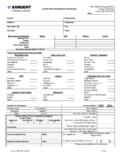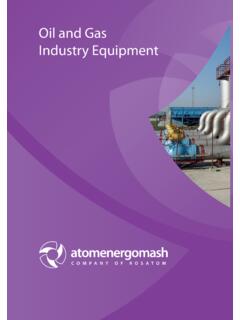Transcription of Welding Codes and How They're Used - Weld Procedure
1 Welding Codes and How They're Used Almost all design, Welding , fabrication, material , repair, testing, and inspection requirements are covered under three main governing organizations. Even the Department of Defense (DOD) has either adopted many of these Codes , or used them as a basis to develop their own Codes known as Mil-Specs. These Codes are recognized by the American National Standards Institute (ANSI). The following list of Codes just barely "scratches the surface" of all existing Codes and code organizations. These are the most common Codes being used, but there are many others. Many complex jobs fall under multiple Codes . These main organizations are the American Welding Society (AWS), the American Society of Mechanical Engineers (ASME), and the American Petroleum Institute (API). All of these organizations have multiple specific Codes for various types of construction, processes, and/or materials.
2 Design specifications and approved materials are included in these Codes . What I am about to list is only the major Codes from these organizations that control metal construction with a brief overview and is not a comprehensive list of every single code that these organizations have available. This information is taken from the latest Codes that are available to me and not necessarily the latest editions of these Codes . If you need a comprehensive up to date list of any or all of their Codes , then you should visit the respective organizations. Think you just landed a contract that doesn't fall under a code? Think again-and read on! American Welding Society AWS This code contains the requirements for fabricating and erecting welded steel structures. This code applies to steels with a thickness of 1/8 inch ( ) or more. When this code is specified in a contract, most of the provisions are mandatory.
3 Optional provisions and examples are shown in an annex included within this code. AWS This is the Structural Welding Code-Aluminum. The Welding requirements are applicable to any type of welded aluminum alloy structure. This code is appropriate for use in fabrication of supporting structures and appurtenances. It is not intended to supplant Codes developed for use in specialized fabrication such as the ASME Boiler and Pressure Vessel Code, aerospace Codes , or military Codes . AWS This is the Structural Welding Code-Sheet Steel. This code covers the arc Welding of structural steel sheet/strip steels including cold formed members which are equal to or less than 3/16 inch (.188 ) in nominal thickness. Three weld types unique to sheet steel, arc spot, arc seam, and arc plug welds are included in this code. AWS This is the Structural Welding Code-Reinforcing Steel. This code shall apply to the Welding of reinforcing steel to reinforcing steel and of reinforcing steel to carbon or low-alloy structural steel.
4 This code shall be used in conjunction with the prescribed general building code specifications and is applicable to all Welding of reinforcing steel using the processes listed in Section , and performed as a part of reinforced concrete construction. When reinforcing steel is welded to structural steel, the provisions of AWS shall apply to the structural steel component. AWS This is the Bridge Welding Code. This code covers Welding fabrication requirements applicable to welded highway bridges. It is to be used in conjunction with the AASHTO Standard Specification for Highway Bridges or the AASHTO LRFD Bridge Design Specifications. This code is not intended to be used for the following: steels with a minimum specified yield strength greater than 690 MPa (100ksi), pressure vessels or pressure piping, base metals other than carbon or low alloy steels, or structures composed of structural tubing.
5 AWS Structural Welding Code-Stainless Steel. This code covers Welding requirements applicable to stainless steel weldments subject to design stress. It shall be used in conjunction with any complementary code or specification for the design or construction of stainless steel weldments. AWS Guide for Steel Hull Welding . This guide is referenced in many contract specifications for building vessels from barges to tugboats. AWS Specification for Under-Water Welding . AWS Guide for Aluminum Hull Welding . Similar to the Steel Hull Welding Guide, but with a special emphasis on the unique properties of aluminum. AWS Specification for Automotive and Light Truck Weld Quality: Arc Welding . AWS Specification for Welding Earth Moving and Construction Equipment. Applies to all structural welds used in the manufacture of earthmoving and construction equipment. This specification reflects the Welding practices employed by manufacturers within the industry and incorporates various methods which have been proven successful by individual manufacturers.
6 AWS Specification for Welding Presses and Press Components. The purpose of this specification is to establish minimum acceptable requirements for weld joint design and the fabrication by Welding of presses and press components, and is not intended to apply to material feed mechanisms and tooling. It shall also apply to the modification or repair by Welding of new or existing presses or press components. American Society of Mechanical Engineers ASME Section I Requirements for Power boilers. Part PW lists the Requirements for Boilers Fabricated By Welding . The rules in Part PW are applicable to boilers and component parts thereof, including piping constructed under the provisions of this Section that are fabricated by Welding and shall be used in conjunction with the general requirements of Part PG as well as with the specific requirements in the applicable Parts of this Section that pertain to the type of boiler under consideration.
7 ASME Section II material Specifications-4 Subparts(A,B,C,D). Subpart A-Ferrous material Specifications. Subpart B-Non-Ferrous material Specifications-Materials. Subpart C-Specifications for Welding Rods, Electrodes, and Filler Metals. Subpart D- Properties-divided into three subparts- 1 Stress Tables. 2 Physical Properties Tables. 3 Charts and Tables for Determining Shell Thickness of Components Under External Pressure. ASME Section III Nuclear-There are Three Subdivisions- Division 1-Rules For Construction of Nuclear Facility Components. Subsection NB lists Class 1 Components. Subsection NC lists Class 2 Components. Subsection ND lists Class 3 Components. Subsection NE lists Class MC Components. Subsection NF covers Supports. Subsection NG deals with Core Support Structures. Subsection NH covers Class 1 Components in Elevated Temperature Service. Division 2-Code For Concrete Reactor Vessels and Containment.
8 Division 3-Containment Systems for Storage and Transport Packaging of Spent Nuclear Fuel and High Level Radioactive material and Waste. ASME Section IV Rules For Construction of Heating Boilers. The rules to Part HG apply to steam heating boilers, hot water heating boilers, hot water supply boilers, and appurtenances thereto. They shall be used in conjunction with the specific requirements of Parts HF and HC whichever is applicable. The forward provides the basis for these rules. Part HG is not intended to apply to potable water heaters except as provided for in Part HLW. ASME Section V Non-Destructive Examination. Unless otherwise specified by the referencing Code Section, or other referencing documents, this Section of the Code contains requirements and methods for nondestructive examination which are Code requirements to the extent they are specifically referenced and required by other Code Sections.
9 These nondestructive examination methods are intended to detect surface and internal discontinuities in materials, welds, and fabricated parts and components. They include radiographic examination, ultrasonic examination, liquid penetrant examination, magnetic particle examination, eddy current examination, visual examination, leak testing, and acoustic emission examination. ASME Section VI Recommended Rules For the Care and Operation of Heating Boilers. This is divided into nine subsections. 1-General, covers scope and terminology. 2-Types of Boilers. 3-Accessories and Installation. 4-Fuels. 5-Fuel Burning Equipment and Fuel Burning Controls. 6-Boiler Room Facilities. 7-Operation, Maintenance, and Repair-Steam Boilers. 8-Operation, Maintenance, and Repair-Hot Water Boilers and Hot Water Heating Boilers. 9-Water Treatment ASME Section VII Recommended Guidelines for the Care of Power Boilers ASME Section VIII Pressure Vessel and Tank Code.
10 This is divided into three sub-divisions. Division 1-Subsection A is general pressure vessel information. Subsection B covers the Requirements Pertaining to Methods of Fabrication of Pressure Vessels. Subsection C lists the Requirements Pertaining to Classes of Materials. Division 2 covers Alternative Rules for Construction of Pressure Vessels. Division 3 lists Alternative Rules for Construction of High Pressure Boilers. ASME Section IX Welding and Brazing Qualifications. This section covers the requirements for Weld Procedure Specifications (WPS), Procedure Qualification Records (PQR), and certification requirements for tackers, welders, Welding operators, and brazing personnel. ASME Section X Fiber-Reinforced Plastic Pressure Vessels. ASME Section XI Rules for In-service Inspection of Nuclear Power Plant Components. ASME Power Piping-This Code prescribes requirements for the design, materials, fabrication, erection, test, and inspection of power and auxiliary service piping systems for electrical generation stations, industrial and institutional plants, central and district heating plants, and district heating systems, except as limited by para.


